Mandalay was made famous in the West by a Kipling poem and the song made from it.
On the road to Mandalay,
Where the flying fishes play,
And the dawn comes up like thunder
Outta China ‘cross the bay.
That was when the British still occupied the country at the turn of the 20th century, and those flying fishes might have been the now endangered Irawaddy River dolphins. And we’re not here in monsoon season, so there is no thunder to report. Also, little sign of those colonial days has survived, as the British pursued its interests out of Yangon, located nearer to sea access, making Mandalay’s more of a backwater.
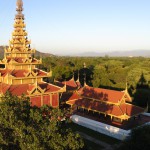
But Mandalay shows traces of a much older empire, when Burma was powerful, and trumpets loudly the country’s devotion to constructing Buddhist shrines, monasteries and nunneries. Not just an obsession with the kings of old, this devotion represents an ongoing, astonishing and even perplexing dedication of national resources.
Mandalay was the last capital of the Burmese kingdom under the last two kings, when it was faltering already. Nearby to the south two other capitals date back a thousand years. Nothing survives of Amarapura to tell the tale of that city. And at the four-time capital Innwa (or Ava to the British), only a trace of the royal buildings remain.
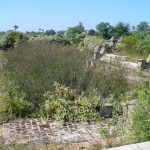
Now it’s home to a modest village of subsistence farmers, who manage to make extra cash off tourists. To see the few sites, you can hire a pony cart, clip-clopping as you might have done 200 years ago, though royal defenders have ceded ground to the pleas of souvenir hawkers of all ages.
Amid these paltry remains, you also find two examples of the spiritual devotion we have seen demonstrated in myriad ways throughout the Mandalay area, prayers in wood, cement and gold.
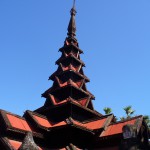
In Ava, one example is the ruin of a 19th century temple built by devotees of Buddha; the other is a massive teakwood structure built by a hermit monk for study and prayer of other monks.
That is the essence of Mandalay: the legacy of the kings, the meager resources of the populace, and the expense they dedicate to religious structures that bring merit for the donors.
Back in the city itself, you do see modernizing. There is just one tall building with perhaps a few on the way. Older two or three story structures offering goods to the wealthy – electronics, mobile phones, fashions – line some of the major bustling streets and new supermarkets are appearing there as well.
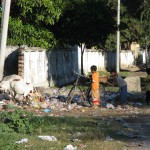
But, just a few blocks away from these streets, you are back on mud streets connecting bamboo thatched wood homes, with roaming cattle and debris strewn widely on land and canals. A few blocks beyond this, you are even further back in time, amid subsistence farmland, with hand tilling, ox-drawn carts and endless plots for rice and peanuts.
But the empire is still visible in the center of the city. There squats the Citadel, the enormous moat encircled city of the last rulers before the British removed them in the early 1800s.

The Citadel is two miles square, and its moat still gleams in a shiny channel. Like the palace grounds in Hanoi, it’s mostly off-limits except to the military. But, within one central portion, you can view the last hurrah of the royal grandees. Though the original teakwood buildings were lost in a firestorm during WWII bombing, the current military leadership reproduced dozens of palace buildings, in cement this time. The buildings are empty, the grounds barren, but the scope and decoration of this copy are grand.
Yet you wonder why, in a poor country, the government would devote so much money to a re-creation of past royal grandeur in the traditional gold and red, the colors of prosperity and power. Or why relocate the capital to a new city out of Yangon, Nay-Pyi-Daw, for that matter. Perhaps the idea was to recall the victorious past of strong central rulers and the time of a powerful Burmese military.
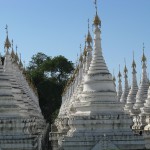
But just as impressive in Mandalay are the manifold investments in spiritual structures. Only a few blocks away, a precisely patterned grid of domes and chapels occupy huge rectangular areas. In the oldest, one of the later kings commissioned an enormous effort to record and thereby preserve the holy Buddhist scriptures and key commentaries. His artisans copied each section of the texts from perishable palm leaf onto a marble tablet about 5 foot tall and 3 foot wide.
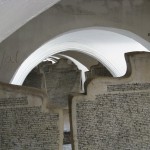
They placed each of these stele into its own domed chapel, a total of 1774 slabs and domes. Across the street, about a hundred years ago, a hermit monk sponsored a similar array with the core texts, about half the number of stele.
A short distance across town, people flock to worship at one of the three holiest images of Buddha, agleam in a golden chapel. The story goes that the Buddha came to the statue and breathed on it. To pay homage, people buy expensive golden statues and flowers from the adjacent stalls. They also purchase gold leaf pieces about an inch square of varying thicknesses and prices.

They apply these to the image itself so that their prayers will be answered. A hundred years ago, the statue’s body was fairly lean; now the endless application of gold leaf has added a foot or more to the lower body and legs so they appear to be covered with gold balls, while the upper body has gathered numerous gold chains and lockets from special givers. Appropriately, in the entryway, a prominent display shows photos of the long-time leader of the country paying tribute to this Buddha.
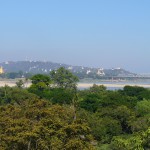
You expect excess from the royal family and the ruling class, but monks and commoners? You can see that even more at the ultimate expressions of piety on the Sagaing Hills, the Beverly Hills of payas or holy places, across the Irrawaddy River. Narrow roads wind up and down the hillsides amid large monasteries and nunneries and payas, over 2000 of them. New ones appear all the time, and the rest are regularly renovated, painted or retouched with gold leaf. More money flows from the well-to-do to support the spiritual activity of the monks and nuns. Why? These hills are considered especially holy and people tell various legends of miracles and wondrous things that occurred here. We heard one tale about one of the many monks who have meditated and prayed in the original limestone caverns. He supposedly entered nirvana while in residence. So some buildings wedged into the hillside offer man-made caverns to satisfy the monastic demand.

Our guide told us that his father had spent thousands of dollars for a paya, an enormous sum for his family. And so different pagodas gather donations based on whether a family had a relative or friend who was a monk there, or tradition for that family, or superstition.
We know that big money in the west can flow into ever larger churches or prayer centers, so that these can function and grow. That is a typical form of devotion. But, here in Mandalay, the average income is only 5 to 10 percent of an American’s. We can afford to add grand houses for the spiritual life.
Here in a very poor country that is trying to advance its material well-being, you keep thinking that spending by the wealthy and all the unwealthy might be best directed somewhat in other ways. Of course, we recognize that too much material gain may not be the right answer either. For, if you believe that creating monasteries and temples is meritorious work, perhaps the trade-off is worthwhile.
(For more pictures from Myanmar, CLICK HERE to view the slideshow at the end of the Myanmar itinerary page.)

